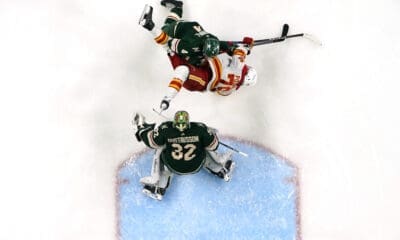Calgary Flames
Another Side of the Story: A #1 Goalie vs Two Above-Average Netminders

I was reading Justin Bourne's story about #1 goalies on Puck Daddy today and found myself surprised at how much I disagreed with him, until I realized that he was giving the player's angle to the goalie debate.
If you don't read Bourne's Blog, you should. He's a good writer and gives a perspective most of us could never have due to his experience.
The point of my disagreement, however, was that I tend to think of hockey in terms of either A) a fan or B) from the front office. I played a lot hockey growing up, but never to a level that would give me insight like Bourne's.
While the players may love having a clear cut #1 goalie, I think the majority of the benefit is in knowing a natural pecking order on the team, which aids in team unity and camaraderie. Basically, know who the top dog is, don't piss him off and you can at least mess with the backup a little.
That's fantastic for the psychological side of the game, but it's only half of the story.
More after the jump.
From a team architecture standpoint, it doesn't make nearly as much sense.
Every NHL team has injuries and they’re extremely catastrophic if they’re to a #1 goaltender. In this case, would you rather have two above-average players each making $3m a year or one “top” goalie making $7m per and a backup that was the best you could get for $800k? Montreal could have kept both Halak and Price for the same cap hit that Henrik Lundqvist is costing the Rangers this season.
If we look at every team in the NHL over the last 3 seasons we have 90 instances of goaltending tandem "portfolios" to examine. In 33 of those 90 seasons, the top GVT in net was not the highest paid goalie on the team. This tells me that while GMs want to anoint their next #1 keeper, they're wrong a fairly high percentage of the time. GMs aren't dumb, goalie performance in the NHL can vary greatly from year to year.
The top-paid goalie on each team had an average GVT of 7.3 in that time span while the goalie with the next most games played had a GVT of 4.0. Yes, the #1 goalies are better but they may not be as cap effective. Teams are successful because they get the most bang for the money they spend. Over the same three seasons, the top-paid goalie on each squad had an average Goals Versus Salary (GVS) of 4.6 while the backups had a GVS of 9.9. Teams with high potential backups have a great avenue for outperforming the dollars they spend.
The final issue is with the disparity of goaltending talent. The difference between a top goalie and an average one can be miniscule and over a small sample period, almost any NHL-caliber goalie can get hot or just plain lucky. Gabe Desjardins shows here that the difference between Roberto Luongo and Michael Leighton could be as little as 2 or 3 wins.
While a true #1 goalie can add some certainty to a squad, I much prefer the combination of a solid, league average goalie and a high-potential backup. It seems to be the most cap effective method.
I like the idea of being able to ride the hot hand and save the extra money for another forward or defenseman, even if it does mean the team will be using the shooter tutor for competitions after practice.
by Ryan Popilchak









